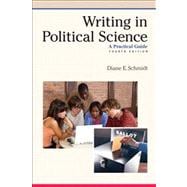
| Preface | p. xi |
| Political Inquiry | p. 1 |
| Introduction | p. 1 |
| The Art of Political Inquiry Defined | p. 2 |
| Types of Student Writing | p. 3 |
| The Process of Political Inquiry | p. 4 |
| Professionalism, Ethical Considerations, and Plagiarism | p. 6 |
| Critical Thinking About Politics | p. 15 |
| Critical Thinking: The Cornerstone of Political Inquiry | p. 15 |
| Critical Thinking and Reasoning | p. 17 |
| Common Problems in Critical Thinking | p. 19 |
| Tips for Critical Thinking | p. 21 |
| Reading Critically to Write Critically | p. 24 |
| Topic Selection | p. 34 |
| Choosing a Topic | p. 34 |
| Tips for Choosing a Topic | p. 36 |
| Locating Research Materials Using Indexes, Databases, and the Internet | p. 44 |
| Introduction | p. 44 |
| Characteristics of Sources Used in Research Papers | p. 45 |
| Distinguishing Between Types of Information | p. 46 |
| Retrieval Systems for Locating Sources | p. 49 |
| Selecting the Right Search Tools for Locating Research Materials | p. 60 |
| Research Strategies for Locating Sources: A Simulation | p. 68 |
| Evaluating the Quality and Reliability of Sources | p. 75 |
| Creating Evidence with Primary and Secondary Data | p. 79 |
| Introduction | p. 79 |
| Secondary Sources of Quantitative Data | p. 80 |
| Creating Primary Data | p. 82 |
| A Primer on Qualitative Data Reduction Methods | p. 92 |
| A Primer on Quantitative Data Reduction Methods | p. 99 |
| A Primer on Data Analysis | p. 103 |
| Properties of Essays and Research Papers | p. 109 |
| Properties of a Good Essay or Research Paper | p. 109 |
| Recognizing and Writing a Good Thesis Sentence | p. 110 |
| Writing a Thesis Sentence for an Essay or Essay Test | p. 110 |
| Writing a Thesis Sentence for a Research Paper | p. 112 |
| Formulating a Thesis Sentence for a Research Paper | p. 114 |
| Recognizing and Writing a Good Paragraph | p. 116 |
| Properties of a Topic Sentence | p. 120 |
| Advice for Constructing Paragraphs in the Body of the Paper | p. 122 |
| Common Writing Problems | p. 126 |
| Common Stylistic Problems | p. 126 |
| Common Errors: Proofreading the Manuscript | p. 129 |
| How to Use a Writing Center | p. 133 |
| What to Do About Writer's Block | p. 134 |
| Manuscript Format and Referencing Styles | p. 136 |
| Criteria for Grading a Research Paper | p. 136 |
| Format and Placement of Items in the Paper or Essay | p. 138 |
| Structure for Endnote and Footnote Citations | p. 150 |
| Structure for Parenthetical Author-Date Citations System | p. 154 |
| Examples of Common Author-Date Citation Styles for Reference Page | p. 159 |
| Format and Examples for Activities to Enhance Comprehension and Synthesis of Class Materials | p. 173 |
| Enhancing Comprehension and Synthesis of Class Materials | p. 173 |
| Writing Analytical Essays | p. 174 |
| Writing Political Editorials | p. 178 |
| Analytical Multiple-Choice Exams | p. 181 |
| Essay Exams | p. 184 |
| Scholarly Literature Review Presentations | p. 186 |
| Media Applications Illustrating Course Materials | p. 190 |
| Format and Examples of Assignments for Managing and Processing Information | p. 197 |
| Assignments for Managing and Processing Information | p. 197 |
| Annotated Bibliographies | p. 198 |
| Book Reviews | p. 202 |
| Research Proposals | p. 210 |
| Constructing Outlines | p. 214 |
| Standard Research Presentations | p. 219 |
| PowerPoint Presentations | p. 225 |
| Format and Examples of Conventional Research Papers | p. 229 |
| Formulas for Organizing Standard Research Papers | p. 229 |
| Writing a Literature Review | p. 230 |
| Writing a Comparative Study | p. 240 |
| Writing an Analysis | p. 247 |
| Writing a Position Paper | p. 256 |
| Format and Examples of Assignments Requiring Special Techniques | p. 265 |
| Assignments Requiring Special Analytical Techniques | p. 265 |
| Analytical Case Study | p. 267 |
| Problem-Solving Case Studies | p. 276 |
| Analysis of Legislation | p. 281 |
| Policy Analysis: Evaluation or Recommendation | p. 300 |
| Researching and Writing a Policy Evaluation | p. 301 |
| Policy Evaluation Guide and Checkoff Sheet | p. 303 |
| Researching and Writing a Policy Recommendation | p. 326 |
| Policy Recommendation Guide and Checkoff Sheet | p. 328 |
| Writing a Policy Memo | p. 348 |
| Participant Observation and Internship Report | p. 351 |
| Writing a Grant | p. 361 |
| Writing a Project Report | p. 372 |
| References | p. 389 |
| Text Acknowledgments | p. 393 |
| Index | p. 395 |
| Table of Contents provided by Ingram. All Rights Reserved. |
The New copy of this book will include any supplemental materials advertised. Please check the title of the book to determine if it should include any access cards, study guides, lab manuals, CDs, etc.
The Used, Rental and eBook copies of this book are not guaranteed to include any supplemental materials. Typically, only the book itself is included. This is true even if the title states it includes any access cards, study guides, lab manuals, CDs, etc.